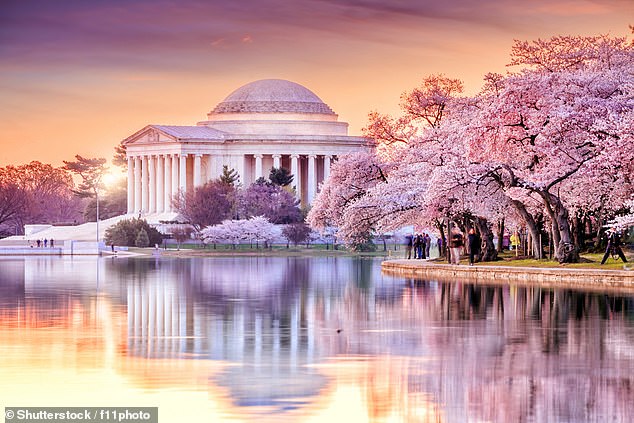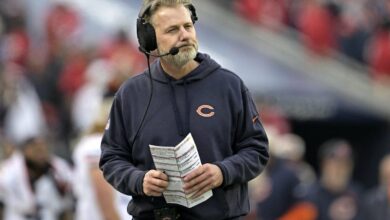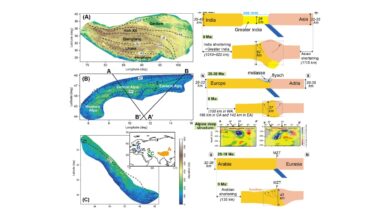With all eyes on Washington and the race for the White House, NEIL DARBYSHIRE visits the US capital… and is impressed by its history and architectural grandeur

Standing in the great circular hall of the Capitol in Washington, the sacred heart of American democracy, you are overcome by an almost tangible sense of awe.
You can feel it in the crowd of American citizens who bring their children to pay homage here. In the guides, the security personnel, even those manning the cloakrooms. Our talkative tour guide, Danny, sums it up neatly: “This is the Capitol, man. Nothing compares to it.”
Thanks to strict building height regulations, the dome of this secular cathedral, topped by the 19ft Statue of Liberty, is reassuringly visible across the city. It has a special resonance as Joe Biden and Donald Trump begin their battle for control of the White House to see who gets bragging rights in this great city.
For a working parliament, it’s remarkably accessible. Even as casual visitors, my wife Isabel and I are in the public gallery to hear a major debate in the Senate. A Republican rails against government spending at a time of mounting national debt. Sound familiar?
We are lucky enough to be in ‘The District’ at the height of the cherry blossom season, when some 3,000 cherry trees, donated by Japan in the early 20th century, bloom around the city’s Tidal Basin.

Impressive sights: Neil Darbyshire believes Washington exudes a “natural warmth.” Above, the city’s Jefferson Memorial during the cherry blossom season
It is a truly magnificent sight, attracting large numbers of visitors and creating a festive atmosphere, with music, street food and stalls proclaiming the beauty of the cherry.
Washington probably doesn’t feature high on most Britons’ list of must-visit American destinations. It’s overshadowed by the bright lights of New York, Vegas and LA, the beaches of Florida and the natural splendor of New England.
Home to thousands of government workers, politicians and their aides, lobbyists and think tankers, it has a reputation for being aloof and closed.

Washington’s towering neoclassical buildings and wide boulevards are reminiscent of Paris, says Neil

The photo shows the Lincoln Memorial and the National World War II Memorial, with The Reflecting Pool
But to us, the city seems to radiate a natural warmth. Almost everyone we meet is engaging and refreshingly British-friendly – remarkably forgiving, considering we had burned the city to the ground in a fit of imperial resentment during the War of 1812.
Isabel and I are visiting our daughter and her partner, who have been living in the Navy Yard neighbourhood, just south of the Capitol, for almost a year. Like the Docklands in London, this was a neglected area that was bulldozed and then gentrified with smart residential and office buildings, vibrant bars and restaurants.
Down at The Wharf we stroll through the open-air fish market, the oldest continuously operating market in the country. Here you can buy all sorts of shellfish and watch as giant prawns are theatrically tossed into enormous woks.
After a few cocktails at one of the many waterfront bars, it’s time for dinner. My favorite meal is at Martin’s Tavern in Georgetown, Washington’s most upscale neighborhood. A family restaurant dating back to the 1930s, presidents and other politicians have gathered in the intimate booths to gossip and plot. Plaques indicate which booths they preferred.
JFK proposed to Jackie here, Tricky Dicky loved the meatloaf, Ted Kennedy had his “cozy corner.” We’re in the Lyndon Johnson booth. I wonder, as I sip my Manhattan, if he discussed the carpet bombing of North Vietnam over juicy lamb chops and baby potatoes.

Neil visits the Watergate Hotel (pictured), which became embroiled in the biggest political scandal in American history

The fish market at The Wharf, where you can watch giant prawns being ‘theatrically’ thrown into enormous woks
Washington, a purpose-built capital, is clearly designed to impress and inspire. Towering neoclassical buildings line broad boulevards reminiscent of Paris. Imposing monuments surround pleasant and expansive public spaces, the most popular of which is the National Mall. This greenway runs for more than two miles from the Lincoln Memorial to the Capitol, and includes the 555ft obelisk dedicated to George Washington and passes by the White House.
Getting around the compact city centre is easy, much of it can be explored on foot, but there are also Ubers, e-bikes and a cheap, clean and efficient metro.
There’s no shortage of museums here, celebrating everything from the Bible to the Space Race. And for a journalist who grew up on the 1970s film All the President’s Men, a visit to the Watergate Hotel is a special treat. My daughter and I tour the “Scandal Room,” from where the infamous burglary that toppled Richard Nixon was planned and executed.
In a year when a presidential election is taking place and the storming of the Capitol by supporters of Donald Trump is still fresh in memory, the hall offers a warning from history about how power can be abused.
But none of this seems to bother our taxi driver Fidelise, who came here eight years ago from troubled West Africa. “What is Washington like for you?” I ask. “A paradise on earth,” he answers, without a trace of irony.




